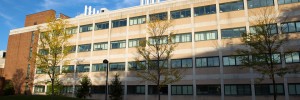Department of Communication and Media Divides to Thrive
The former Department of Communication and Media has begun its first academic year as two distinct departments, the Department of Communication and the Department of Digital Media and Journalism, and there is much cause for celebration.
A streamlined organizational structure, successful searches for high-caliber faculty and equipment upgrades have brought new excitement and efficiency to departments that have seen rapid growth in recent years.
The Department of Communication has 218 majors, and the Department of Digital Media and Journalism has 391 majors. Both departments have a healthy number of pre-majors and minors.
Stability in leadership has helped ease the transition. Former Communication and Media department chair Jason Wrench now chairs the Department of Communication, while former associate chair Jerry Persaud chairs the Department of Digital Media and Journalism. Both have adjacent offices in the Coykendall Science Building (CSB) and share secretarial support.

Having worked together closely in the past, Wrench and Persaud have an easy rapport and welcome the opportunity to focus on their areas of expertise.
“We have curriculum differences,” noted Wrench. “[The department division] makes things a lot more manageable; you’re a lot more focused. I know my curriculum. I know what’s going on.”
The Department of Communication offers a major in communication studies, with concentrations in interpersonal-intercultural communication, organizational communication and public relations. The Department of Digital Media and Journalism offers majors in journalism, media management and digital media production, as well as a 4+1 BA/MBA program, in partnership with the School of Business.
The departments completed six successful searches last year and hired all of their first choices. “We were really excited. It’s new blood for the departments, a time of change all around,” said Wrench.
Joining the Department of Communication faculty are Julie Taylor, who will teach courses in organizational communication, and Catherine Thweatt, who specializes in interpersonal communication.
Digital Media and Journalism newcomers Todd Holmes and Will Hong will teach media management and digital media courses, respectively, and Rachel Sommerstein will join the journalism faculty. Award winning filmmaker Thomas Cznarty, an interim one-year lecturer last year, will return as a three-year renewable lecturer in digital media production.
The addition of 15 industry standard Mac computers has allowed Digital Media and Journalism to expand its editing suites in CSB 25 and 55. Students now have access to 25 Avid Media Composer stations in multi-use labs that better serve the department’s student population.
“Students have access that they didn’t have before,” said Persaud, noting that students no longer have to wait in line to complete homework assignments and video projects.
Branding efforts are underway in both departments. The Department of Communication and the Department of Digital Media and Journalism have new logos and university web pages. Wrench has created a new communication Facebook page and LinkedIn group, and aims to develop a new magazine for current students and alumni.
Expanding offerings to accommodate student demand will be among the departments’ greatest challenges in the future. Wrench said his department continues to see more majors who declare as juniors after taking general education courses like Communication Among Cultures or Storytelling in Culture.
“Most people coming out of high school have no idea what Communication is,” said Wrench, noting that late-comers to the major and the explosion of students entering public relations are also national trends. Ninety-two students are currently enrolled in the public relations concentration, a number Wrench said is “growing every day.”
The Department of Digital Media and Journalism continues to attract new majors as well. “We’re having continued growth into the department, and that’s because this is the digital age, the visual age, and that’s our student body,” said Persaud.
